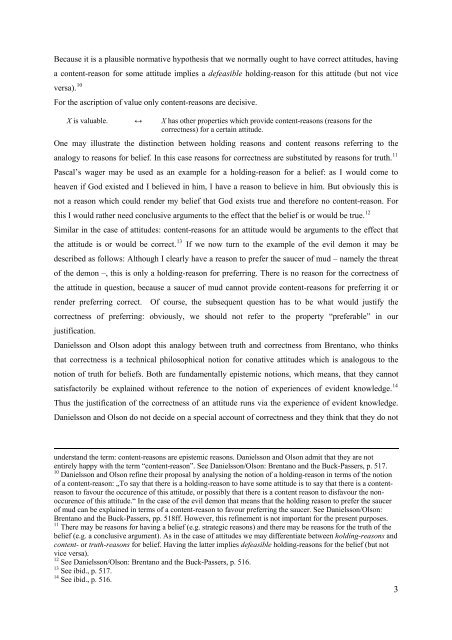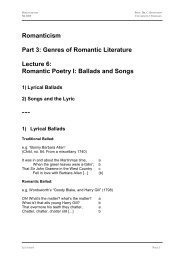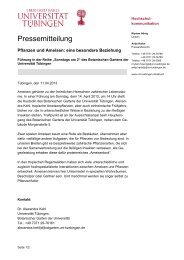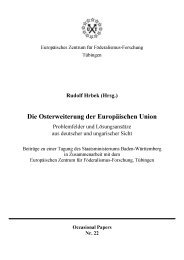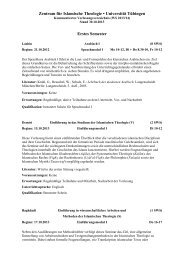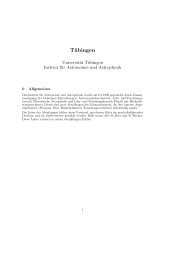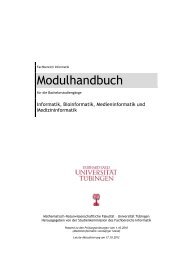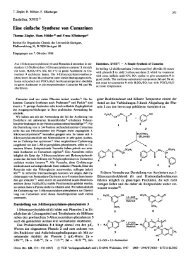Eberhard Karls Universität Tübingen
Eberhard Karls Universität Tübingen
Eberhard Karls Universität Tübingen
Create successful ePaper yourself
Turn your PDF publications into a flip-book with our unique Google optimized e-Paper software.
Because it is a plausible normative hypothesis that we normally ought to have correct attitudes, having<br />
a content-reason for some attitude implies a defeasible holding-reason for this attitude (but not vice<br />
versa). 10<br />
For the ascription of value only content-reasons are decisive.<br />
X is valuable. ↔ X has other properties which provide content-reasons (reasons for the<br />
correctness) for a certain attitude.<br />
One may illustrate the distinction between holding reasons and content reasons referring to the<br />
analogy to reasons for belief. In this case reasons for correctness are substituted by reasons for truth. 11<br />
Pascal’s wager may be used as an example for a holding-reason for a belief: as I would come to<br />
heaven if God existed and I believed in him, I have a reason to believe in him. But obviously this is<br />
not a reason which could render my belief that God exists true and therefore no content-reason. For<br />
this I would rather need conclusive arguments to the effect that the belief is or would be true. 12<br />
Similar in the case of attitudes: content-reasons for an attitude would be arguments to the effect that<br />
the attitude is or would be correct. 13 If we now turn to the example of the evil demon it may be<br />
described as follows: Although I clearly have a reason to prefer the saucer of mud – namely the threat<br />
of the demon –, this is only a holding-reason for preferring. There is no reason for the correctness of<br />
the attitude in question, because a saucer of mud cannot provide content-reasons for preferring it or<br />
render preferring correct. Of course, the subsequent question has to be what would justify the<br />
correctness of preferring: obviously, we should not refer to the property “preferable” in our<br />
justification.<br />
Danielsson and Olson adopt this analogy between truth and correctness from Brentano, who thinks<br />
that correctness is a technical philosophical notion for conative attitudes which is analogous to the<br />
notion of truth for beliefs. Both are fundamentally epistemic notions, which means, that they cannot<br />
satisfactorily be explained without reference to the notion of experiences of evident knowledge. 14<br />
Thus the justification of the correctness of an attitude runs via the experience of evident knowledge.<br />
Danielsson and Olson do not decide on a special account of correctness and they think that they do not<br />
understand the term: content-reasons are epistemic reasons. Danielsson and Olson admit that they are not<br />
entirely happy with the term “content-reason”. See Danielsson/Olson: Brentano and the Buck-Passers, p. 517.<br />
10<br />
Danielsson and Olson refine their proposal by analysing the notion of a holding-reason in terms of the notion<br />
of a content-reason: „To say that there is a holding-reason to have some attitude is to say that there is a contentreason<br />
to favour the occurence of this attitude, or possibly that there is a content reason to disfavour the nonoccurence<br />
of this attitude.“ In the case of the evil demon that means that the holding reason to prefer the saucer<br />
of mud can be explained in terms of a content-reason to favour preferring the saucer. See Danielsson/Olson:<br />
Brentano and the Buck-Passers, pp. 518ff. However, this refinement is not important for the present purposes.<br />
11<br />
There may be reasons for having a belief (e.g. strategic reasons) and there may be reasons for the truth of the<br />
belief (e.g. a conclusive argument). As in the case of attitudes we may differentiate between holding-reasons and<br />
content- or truth-reasons for belief. Having the latter implies defeasible holding-reasons for the belief (but not<br />
vice versa).<br />
12<br />
See Danielsson/Olson: Brentano and the Buck-Passers, p. 516.<br />
13<br />
See ibid., p. 517.<br />
14<br />
See ibid., p. 516.<br />
3


